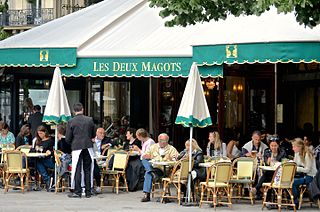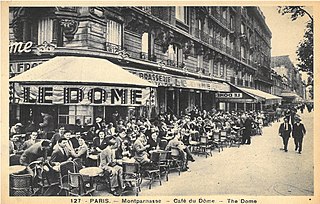Montparnasse is an area in the south of Paris, France, on the left bank of the river Seine, centred at the crossroads of the Boulevard du Montparnasse and the Rue de Rennes, between the Rue de Rennes and boulevard Raspail. It is split between the 6th, 14th, and 15th arrondissements of the city. Montparnasse has been part of Paris since 1669.

The 6th arrondissement of Paris is one of the 20 arrondissements of the capital city of France. In spoken French, it is referred to as le sixième.

Boulogne-Billancourt is a wealthy and prestigious commune in the western suburbs of Paris, France, located 8.2 km (5 mi) from the centre of Paris. It is a subprefecture of the Hauts-de-Seine department and thus the seat of the larger arrondissement of Boulogne-Billancourt. It is also part of the Métropole du Grand Paris. Boulogne-Billancourt includes one island in the Seine: Île Seguin. With a population of 121,334 as of 2018, it is the most populous commune in Hauts-de-Seine and most populous suburb of Paris, as well as one of the most densely populated municipalities in Europe.

"Les Six" is a name given to a group of six composers, five of them French and one Swiss, who lived and worked in Montparnasse. The name has its origins in two 1920 articles by critic Henri Collet in Comœdia. Their music is often seen as a neoclassic reaction against both the musical style of Richard Wagner and the Impressionist music of Claude Debussy and Maurice Ravel.
The Prix des Deux Magots is a major French literary prize. It is presented to new works, and is generally awarded to works that are more off-beat and less conventional than those that receive the more mainstream Prix Goncourt.

Jean Carmet was a French actor.
Jean-Paul Crespelle was a journalist and author. He was born in Nogent-sur-Marne, Île-de-France, France.

Jean Béraud was a French painter renowned for his numerous paintings depicting the life of Paris, and the nightlife of Paris society. Pictures of the Champs Elysees, cafés, Montmartre and the banks of the Seine are precisely detailed illustrations of everyday Parisian life during the "Belle Époque". He also painted religious subjects in a contemporary setting.

The School of Paris refers to the French and émigré artists who worked in Paris in the first half of the 20th century.

Les Deux Magots is a famous café and restaurant situated at 6, Place Saint-Germain-des-Prés in Paris's 6th arrondissement, France. It once had a reputation as the rendezvous of the literary and intellectual elite of the city. It is now a popular tourist destination. Its historical reputation is derived from the patronage of Surrealist artists, intellectuals to the likes of Simone de Beauvoir and Jean-Paul Sartre, as well as young writers, such as Ernest Hemingway. Other patrons included Albert Camus, Pablo Picasso, James Joyce, Bertolt Brecht, Julia Child and the American writers James Baldwin, Chester Himes and Richard Wright.

Louis Marcoussis, formerly Ludwik Kazimierz Wladyslaw Markus or Ludwig Casimir Ladislas Markus, was a Polish-French avant-garde painter active primarily in Paris. Markus studied law in Warsaw before attending the Kraków Academy of Fine Arts, and later moved to Paris to study under Jules Lefebvre at the Académie Julian. His work was first featured in a major exhibition at the Salon d'Automne in 1905. In Paris, he became acquainted with prominent artists of the School of Paris and writers in the cafes of Montmartre and Montparnasse.

André Salmon was a French poet, art critic and writer. He was one of the early defenders of Cubism, with Guillaume Apollinaire and Maurice Raynal.

Le Dôme Café or Café du Dôme is a restaurant in Montparnasse, Paris that first opened in 1898. Based on the example established by La Closerie des Lilas and followed by Café de la Rotonde, Le Select, and La Coupole, Le Dôme was renowned as an intellectual gathering place for artists and writers during the interwar period. Le Dôme created and disseminated gossip and provided message exchanges and an 'over the table' market that dealt in artistic and literary futures. It was frequented by painters and sculptors of the School of Paris as well as writers, poets, models, art connoisseurs and dealers.

The Café de la Rotonde is a famous café in the Montparnasse Quarter of Paris, France at 105 Boulevard du Montparnasse, known for its artistic milieu and good food. In its official website, La Rotonde defines itself as a brasserie and restaurant. Located on the Place de Picasso, that also holds the sculpture of Honoré de Balzac by Auguste Rodin called Monument to Balzac at the corner of Boulevard du Montparnasse and Boulevard Raspail, it was founded by Victor Libion in 1911. Based on examples established by La Closerie des Lilas and Le Dôme Café, La Rotonde, along with La Coupole and Le Select, was renowned as an intellectual gathering place for notable artists and writers during the interwar period due to its open atmosphere and reasonable prices. Unlike many establishments in Montparnasse, La Rotonde has retained much of its bohemian charm and continues in operation to this day as a popular and chic spot for classic French cuisine lovers and the Parisian artistic intelligentsia.
Le Bal du comte d'Orgel is a French novel by Raymond Radiguet (1903–1923). The second and last novel by the Parisian author, it was published posthumously in 1924. Set as a love triangle during the années folles, it proved controversial, as did his first psychological novel, Le Diable au corps, published in 1923. Le Bal du comte d'Orgel was adapted into a 1970 film.

The Années folles was the decade of the 1920s in France. It was coined to describe the social, artistic, and cultural collaborations of the period. The same period is also referred to as the Roaring Twenties or the Jazz Age in the United States. In Germany, it is sometimes referred to as the Golden Twenties because of the economic boom that followed World War I.
Laurent Durand was an 18th-century French publisher active in the Age of Enlightenment. His shop was established rue Saint-Jacques under the sign Saint Landry & du griffon.

François Paul Lachenal was a Swiss publisher and diplomat, who beginning in 1940 played a significant role in publishing the writings of the French authors during the occupation of France by Germany. He was member of the Swiss delegation in Vichy till 1944 and later till 1945 at the Swiss embassy in Berlin. Publisher of the magazine Traits he was son of Genevan politician Paul Lachenal, nephew of The president of the Swiss Confederation Adrien Lachenal and married to Johanna Bertha Caroline Otken. He is buried at the Cimetière des Rois in Geneva.

The Closerie des Lilas is a famous Parisian restaurant located on boulevard du Montparnasse in the 6th arrondissement of Paris.
Le Monocle was a Parisian lesbian bar, opened in the 1920s by Lulu de Montparnasse. Located on Boulevard Edgar-Quinet, it closed during the occupation of France by Germany in World War II.















